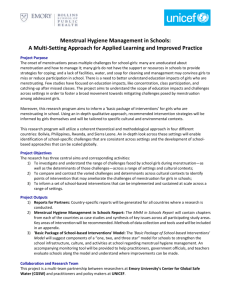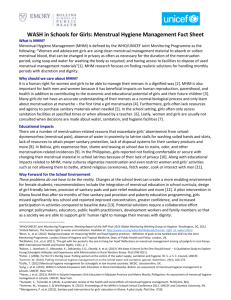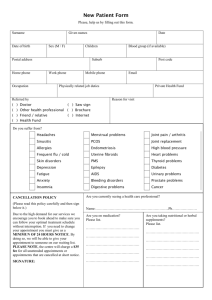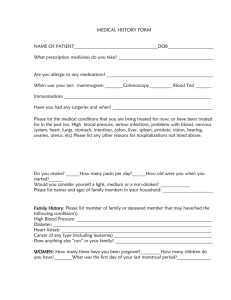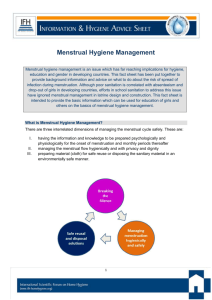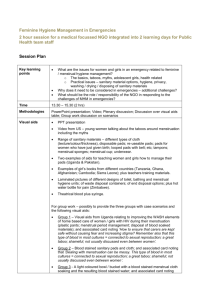Menstrual hygiene management: the basics
advertisement
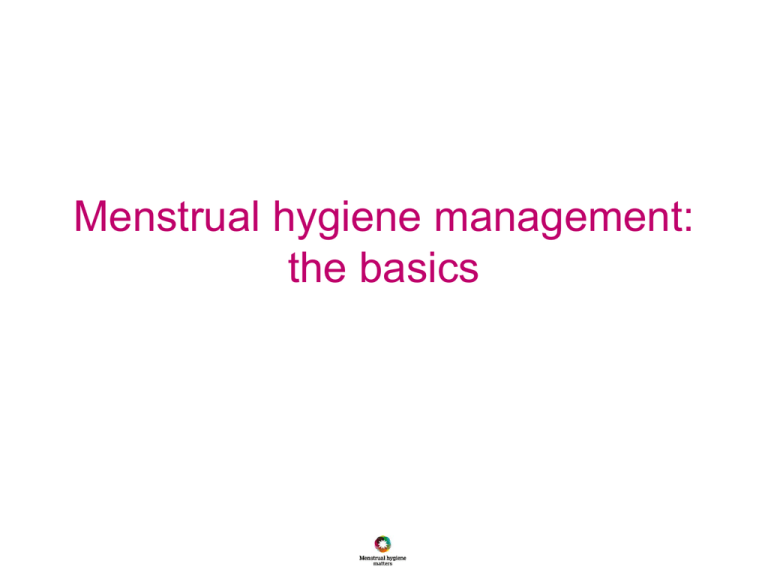
Menstrual hygiene management: the basics Introduction • What are menstruation and menstrual hygiene management (MHM)? • Challenges faced by girls and women • MHM and health • Key components of MHM • Inclusive MHM • Cross-sectoral roles • Menstrual hygiene matters resource book What is menstruation? • A natural bodily function and vital sign of good reproductive health • Girls typically start to menstruate between ten and 18 years old • Results in bleeding from womb (uterus) and through the vagina • Usually occurs monthly for between two to seven days • Average amount of blood lost is 30-40ml – some lighter flow and some heavier flow days Picture: Kanyemba A (2011) Growing up at school, a guide to menstrual management for school girls. Zimbabwe: Water Research Commission, South Africa. The menstrual cycle Days 1-7: 8-11: 12-15: 16-25: 26-28: • • Process menstruation tissue and blood line the walls of the uterus ovulation lining of uterus dissolves (if the egg is not fertilised) the lining detaches, leading to menstruation Approx. every 28 days but may be 21-35 May be irregular, especially in first 1-2 years Picture: Based on UNICEF (no date) Flow with it, babe! Let’s talk about feminine hygiene. East Africa. Menstruation is a vital sign of health • It is a natural process and a vital sign of the healthy reproductive cycle of women and girls. • It is not a sickness but women and girls may suffer from abdominal pains, nausea, tiredness, headache, back ache or discomfort. • Women and girls may also have feelings of sadness or irritation due to hormonal changes. • These experiences vary from person to person and over time. Menstrual hygiene definition Women and adolescent girls are using a clean menstrual management material to absorb or collect menstrual blood, that can be changed in privacy as often as necessary for the duration of a menstrual period, using soap and water for washing the body as required, and having access to safe and convenient facilities to dispose of used menstrual management materials. They understand the basic facts linked to the menstrual cycle and how to manage it with dignity and without discomfort or fear. Drafted by JMP Hygiene Working Group, 2012 Challenges faced by girls and women • Lack of sanitary protection materials – leading to embarrassment and stress due to leakage and smell • Lack of menstrual hygiene-friendly facilities – so unable to change materials and wash, leading to absence from school or work • Fear of using the latrine – due to staining or lack of privacy or unsafe location Excluded from WASH facilities • In some communities, women and girls are not allowed to use water sources during menstruation. • In communities in Gujarat, India, 91% of girls reported staying away from flowing water. • In a study in South Asia, 20% of the women interviewed, who had access to toilets, did not use them during their periods, partly due to fear of staining the toilet. Challenges faced by girls and women • Less concentration and participation – including standing up to answer questions at school, due to worries about leakage or pain • Lack of knowledge – leading to fear, embarrassment and unhygienic practices • Exclusion from daily activities – due to discomfort, concern over leakage or cultural restrictions Lack of knowledge, guidance and support “I didn’t know what was happening or what to do to manage menstruation. I used cotton wool, pages from an exercise book, leaves from trees. I suffered much embarrassment at school because I leaked and stained my uniform.” Woman, Tanzania “Guidance and support at school is more important than anything. There is nobody to talk to. When we have problems we just run from class and go home.” Student, Malawi Excluded from home “The gods get angry if we enter the house during menstruation. I don´t worry about myself but I can´t sleep properly when my daughter is in chhaupadi, vulnerable to snakes and the freezing cold.” Woman, Nepal Menstrual hygiene and health • Limited evidence on actual health impacts, but plausible link with poor menstrual hygiene. • Distinction between menstrual disorders and health conditions associated with poor menstrual hygiene. • Menstrual hygiene may be a greater challenge for those suffering incontinence, fistula or female genital mutilation. What is health? Health is a state of complete physical, mental and social well-being and not merely the absence of disease or infirmity. World Health Organization (1948) Breaking the chain of silence Women and girls’ lack of involvement in decision making Lack of information and awareness Lack of social support Lack of access to products and facilities Menstrual hygiene requires • access to accurate and pragmatic information • access to menstrual hygiene materials • access to facilities that provide privacy • access to water and soap within a place that provides an adequate level of privacy • access to disposal facilities for used menstrual materials Pragmatic information Pictures and photo (clockwise from left): WaterAid; Sommer M; UNICEF; Tridhara Photography/ Anisur Rahman MHM-friendly WASH facilities Latrine design Bangladesh • Wider chamber • Washing platform and water inside cubicle • Rail for drying/hanging cloths • Disposal? Photo: WaterAid MHM-friendly WASH facilities School latrine design India • Water inside the latrine • Integrated incinerator • Disposal bin Photo: WaterAid Sanitary materials, supply, and disposal Pictures and photo (left to right): AFRIpads; Tridhara Photography/ Anisur Rahman; WaterAid All girls and women are not the same • Culture, language, religion • Household context • Living in institutions • Age and maturity • Differently-abled • Especially vulnerable or marginalised circumstances Photo: WaterAid/ Caroline Irby Vulnerable and marginalised contexts Photo: WaterAid/ Therese Mahon Challenges faced by girls with disabilities • Less access to facilities, materials and information • Unable to see leaks or extent of blood • Have to sit on dirty latrine to change pads or cloths • May need support to change their pads or cloths • Cannot communicate their pain or discomfort and may have heightened sensitivity Illustration: IASC WASH Cluster Visual Aids Library Sector roles • WASH • Health • Education • Gender • Private sector • Social protection Photo: Tridhara Photography/ Anisur Rahman Menstrual hygiene matters: a practical and comprehensive resource Photos: Tridhara Photography/ Anisur Rahman; Moto Michikata Menstrual hygiene matters training guide and resource book available for download at: www.wateraid.org/mhm
